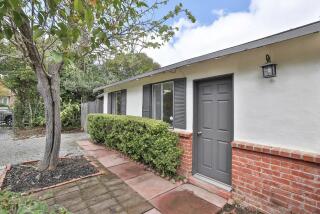Pricing’s Tangled Web
Kathleen Shilkret guessed her five-bedroom Linda Vista house, with its roomy lot and inviting backyard, was worth around $400,000. By one estimate, she was $300,000 on the low side. By another, she was $50,000 too high.
To verify her estimate, Shilkret turned to the Internet and found a home valuation calculator at https://www.homegain.com. The calculator produced a stunning reply: Shilkret’s 1950s-era home has a value range of $600,000 to $700,000. The results prompted the 57-year-old retiree, who wants to sell her home to create a nest egg, to call a real estate agent.
“I was basing my estimate on an appraisal I got almost five years ago,”Shilkret said. “This certainly has helped move me along as far as making a decision to sell.”
But several other Web sites gave Shilkret wildly differing estimates for her home, causing her to wonder about each estimate’s accuracy. Shilkret’s experience underscores confusion among consumers about how to interpret the abundance of real estate information online.
First, dot-coms liberated lists of homes for sale from Realtors and made them available to consumers. Now the global computer network is chipping away at the real estate industry’s hold on “comparables”or “comps.”
Comps list the sales prices of homes that have sold near a specific home in the last six months and are similar in size, age and condition. This information is contained in public records that until now have been difficult and time-consuming for consumers to access.
Agents use comp databases to compare historical sales price trends in a neighborhood. This information helps agents price a specific home by comparing it to similar homes nearby. Today, consumers can do the same by accessing comps for free at a handful Web sites, including HomeGain.com,https://www.domania.com and https://homeadvisor.msn.com.
There’s a lot at stake: These sites use comps in part to determine a value for a consumer’s home--often their most valuable asset. But home valuation calculators can overestimate or underestimate a home’s value, causing consumers to base crucial financial decisions on inaccurate information.
Understanding how home valuation Web sites work can help consumers determine if they’re valuing a home properly.
These sites use computer programs called “automated valuation models,” or AVMs, that cull tax assessments and deeds for information including demographics, property characteristics and sales price trends. Some programs use mortgage, multiple listings and appraisal data.
AVMs run a homeowner’s address and ZIP Code through various mathematical models that compare the home against others that have recently sold in the same area and against historical sales trends in that region.
Some of the more sophisticated models compare a home’s unique characteristics, such as number of bedrooms and baths, to others like it, rather than lumping it in with everything that’s been sold in the same ZIP Code.
Homeowners can use the range of value they get for their home from these sites as a starting point in deciding to sell, refinance or take out a home-equity loan for remodeling. AVMs can also be useful for buyers in a bidding war.
“In a hot market consumers can walk into an open house and be pressured into making an offer on the spot,” said Nick Karris, an Internet real estate analyst at Gomez Advisors, a Lincoln, Mass.-based research firm. “If they want to compete and they’ve never seen an appraisal, they can go out to their car and sign on to see what homes in the area sold for.”
Banks have used AVMs for years to review appraisers’ estimates and in lieu of an appraisal on home-equity loans and in deals where there is a low risk of default. Some mortgage lenders are starting to use these databases for loan originations as well.
The use of AVMs by an increasing number of mortgage lenders promises to save consumers time and money. An in-person appraisal can range from $300 to $500 and take from one to three weeks. A virtual appraisal takes minutes and runs about $25. (Banks typically use huge AVM databases provided by Freddie Mac and Fannie Mae and other AVM providers that charge fees.)
Appraisers say AVM databases are useful to take the pulse of housing prices in a particular neighborhood. But they’re quick to add that an in-person inspection by an appraiser is still the most accurate way to determine a home’s true value.
“They’re useful as generalities, but every property needs to stand on its own,” said Carol Chirpich, a certified residential appraiser in Orange County.
Indeed, whether they’re used by consumers, real estate agents or mortgage lenders, AVMs are not foolproof.
For one thing, assessors’ records and other property data are far from complete.
“The reality is that no one has perfect data,” said Bradley Inman, chief executive of HomeGain.com. “There are some subtle differences in data, but no one can change the fact that certain states don’t have data and some people don’t report changes in data.”
Seven states, including Texas, New Mexico, Kansas, Mississippi, Indiana, Wyoming and Utah, do not make property records available to the public. In states that make information available, such as California, there can be a 60-to-90-day lag between a home’s sale and when the information is recorded.
In addition, Web sites that compare home price trends in a given area may skew a home’s price by evaluating it against homes that are larger or smaller, or have different amenities.
“A home with avocado carpet, paisley wallpaper and a cottage cheese ceiling that’s dark and dingy could be valued the same as a home down the street that’s absolutely beautiful with architectural significance,” said David Offer, an agent at Prudential-John Aaroe Realty and Associates in Brentwood.
The computer doesn’t know, for instance, that Shilkret lives at a T-intersection on a busy street. Or that she’s a few blocks away from an expansive view of the Brookside Golf Course and the Rose Bowl. Or that her tree-lined street meanders into the hills shortly after it passes her house.
Real estate agents don’t like the idea of clients relying on AVMs alone to set their home’s value.
Fred Sands, chairman and chief executive officer of Fred Sands Realtors, says he’s had clients whose homes have been undervalued by home valuation sites. He adds it’s important that homeowners consult with an agent when they’re viewing comps, because agents are able to weed out bad data.
“We find that 20% to 25% of the data we get for comps is erroneous,” Sands said.
Overvaluing a home is also a problem with AVMs. This can cause a consumer to overprice the home, potentially keeping it on the market for months. A recent study by Standard & Poor’s found that while AVMs are accurate for some properties, inaccuracies can result in an overestimate of property value by as much as 200%.
How does a consumer know if a home valuation site is providing accurate information?
Experts suggest that consumers gauge how complete public records data is for their area by closely evaluating comps provided by home valuation sites.
If the comps include details, such as the year the home was built, its square footage, its previous sale price and the number of bedrooms and baths, then it’s likely public records for that area are complete, said Lewis Allen, chief executive and president of Activesoft Technologies, an Irvine-based AVM provider.
Consumers should also check the size of the databases used by each Web site. For example, domania.com says it has access to 78% of the public records for homes sold nationwide over the last five to eight years. But the company doesn’t have property information from numerous states.
It’s also helpful to review the area that comparables for each home are pulled from (i.e. the same street, neighborhood or ZIP Code.) Thisinformation helps to determine if homes in this radius are similar to each other or not, experts say.
“If your house is homogenous to the housing stock in your market, then it’s probably a good estimate of what its value is,” said Forrest Pafenberg, director of real estate finance research at the National Assn. of Realtors. “If you live in a market where homes are atypical, using that information is misleading and might give you comfort where you shouldn’t have it.”
Because accurate property data is hard to come by in some areas, most AVMs have an average hit rate of 60%--meaning only a little more than one in two queries comes up with an answer. This rate is likely to be higher in urban areas where there’s more information, and lower in rural neighborhoods.
On the plus side, AVMs can help stem bias on the part of real estate agents.
“While an agent has a fiduciary responsibility to represent the buyer, they don’t get paid unless that buyer actually purchases something,” Karris said, “so some would say the agent has an incentive to encourage that buyer to pay a high price.”
Like real estate agents, many appraisers view online AVMs as a threat, and are trying to develop AVM databases of their own. The industry’s largest trade group, the Appraisal Institute, unveiled its “Appraisal Institute Residential Database” this month. The database is expected to have 12 million records by next month.
For a fee, consumers will be able to access the database, which includes up-to-date property reports compiled by appraisers nationwide, by the end of the year. The database will allow consumers to enter the price range, size of the home and type of neighborhood they’re interested in. It will then use these criteria to provide a listing of comparable homes in that area.
The difference between this database and other AVMs is its use of property reports made by appraisers, rather than relying solely on property sales records.
Consumers should use AVMs like this to get a rough idea of what their home is worth, but consult a professional to set the final value, said Alan Hummel, a certified residential appraiser who sits on the appraisal institute’s board of directors.
Indeed, marketing executive Liz Siegel used an AVM to confirm the value of her Silver Lake home--after she set a price for it based on a real estate agent’s advice. She enjoyed having the additional information at her fingertips, but felt uneasy interpreting it herself.
“A Realtor does help a lot in terms of knowing more about what adds value and doesn’t add value to the house,” said Siegel. “It’s really hard to make these comparisons yourself.”
Online appraisals
Web sites that help consumers determine the value of their homes often come up with wildly divergent estimates. Why? Each site interprets real estate information differently. This is evident in homeowner Kathleen Shilkret’s case. According to estimates by several dot-coms, the value of Shilkret’s five-bedroom Pasadena home could fall between $351,177 and $700,000. Here’s how the sites arrived at their estimates:
Homegain.com
Estimate: $600,000 to $700,000
Information provided: Year her home was built, lot area, number of bedrooms and baths, assessed value and last sale.
Methodology: Homegain.com pays a third party, Solimar.net, to collect property record information and for the use of its home valuation software. Solimar.net uses a mix of methodologies, including indexing and neural technology--a system designed to function as a human brain does--to arrive at a value range for a home.
Coverage: 461 counties in 41 states.
Accuracy: Index models rely on ZIP Codes to look up historical price trends in an area but don’t take into account a home’s individual characteristics. This practice can skew a home’s value by comparing it to homes that are larger or smaller.
Domania.com
Estimate: $460,378
Information provided: These database records go back only five toseven years, so the site wouldn’t accept the original price Shilkret paid for her home and the year she purchased it. The calculator accepted a $350,000 appraisal that Shilkret received for her home in 1995.
Methodology: Five ways are used to search “comps,”--comparable sales made within the area in the last six months--including comparing the home with others in the same neighborhood, on the entire street or 200 numbers above and below the address given.
Coverage: Has access to more than 21 million home records going back five to seven years. This information covers about 78% of the U.S. but doesn’t include communities in 25 states.
Accuracy: Domania.com uses indexing to determine a home’s value by calculating the rate of change in home values in the area since the home was purchased. It takes this rate of change and applies it to the home’s original selling price. The problem: In some neighborhoods, homes may appreciate or depreciate faster than the rate used to calculate a home’s value.
Homeadvisor.com
Estimate: $351,177 to $509,715, with a medium confidence level (based on how much information the site has to determine a price)
Information provided: The home’s square footage, lot size, year built, assessed value and number of bedrooms and baths.
Methodology: Homeadvisor.com uses comps provided by Freddie Mac as well as historical sales information and property characteristics such as the number of bedrooms and baths.
Coverage: About 2,750 counties in all 50 states. (Because it has access to loan records, Freddie Mac can provide information on properties in states that don’t publicly disclose property records.)
Accuracy: The site didn’t take into account the condition of Shilkret’s home, any improvements and fluctuations in the real estate market in her area.






